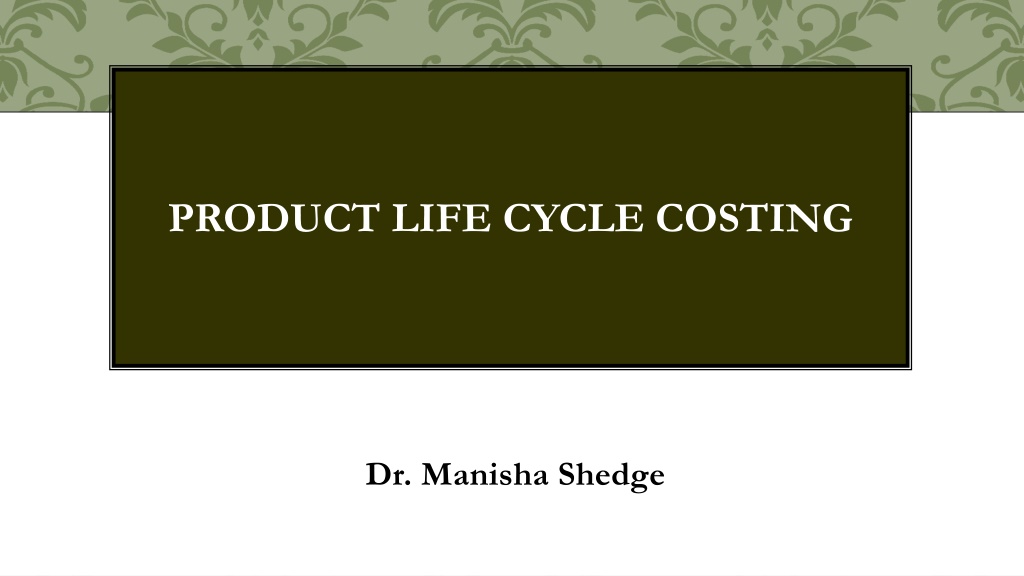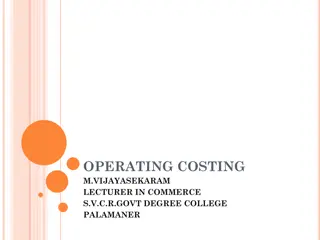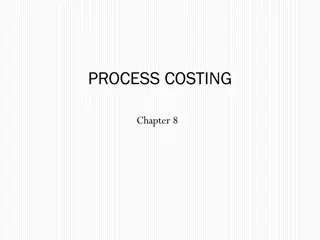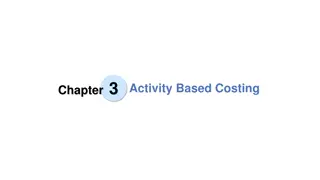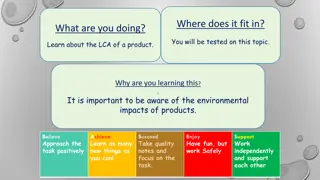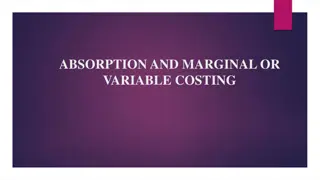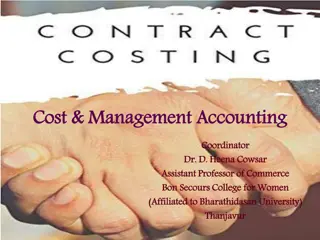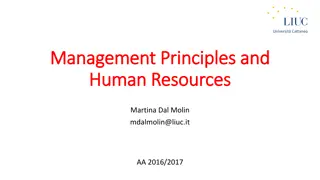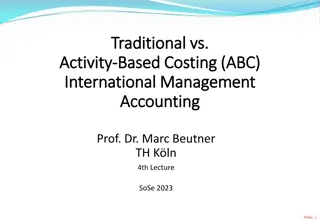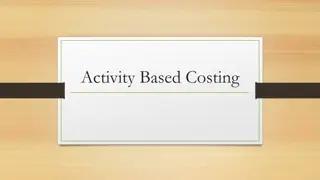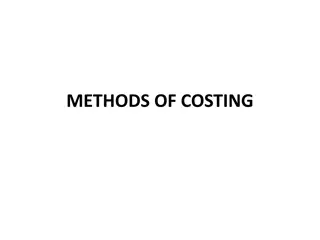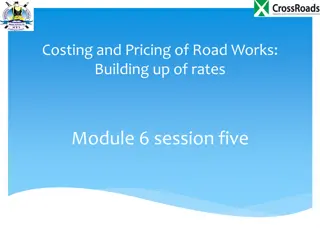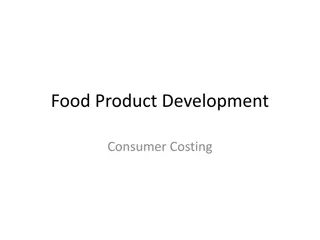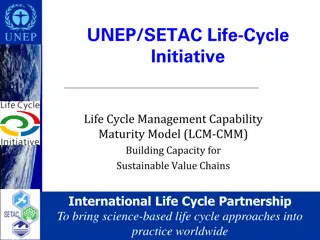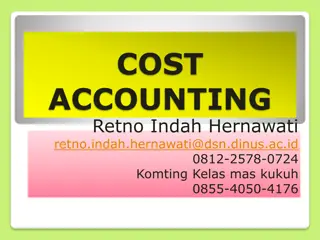Understanding Product Life Cycle Costing: A Comprehensive Analysis
Lifecycle costing involves tracking cost records of assets throughout their entire lives, optimizing asset usage at minimal cost. Product lifecycle costing accumulates a product's costs from inception to disposal, with stages like Introduction, Growth, Maturity, and Decline. It helps assess profitability over a product's entire life, considering costs from activities like Research & Development, Design, Manufacturing, Marketing, and Distribution. Maximizing profitability involves designing costs out, reducing time to market, and extending the lifecycle. Lifecycle cost analysis includes life cycle assessment and whole life cost evaluation, aiding decision-making based on environmental impacts and total ownership costs. Examples of life cycle costing applications include Aircrafts, Military systems, Automobiles, Industrial Equipment, Buildings, and Computers.
- Product Life Cycle Costing
- Asset Management
- Whole Life Cost Analysis
- Environmental Impact Assessment
- Profitability Analysis
Download Presentation

Please find below an Image/Link to download the presentation.
The content on the website is provided AS IS for your information and personal use only. It may not be sold, licensed, or shared on other websites without obtaining consent from the author. Download presentation by click this link. If you encounter any issues during the download, it is possible that the publisher has removed the file from their server.
E N D
Presentation Transcript
PRODUCT LIFE CYCLE COSTING Dr. Manisha Shedge
INTRODUCTION Lifecycle costing is the maintenance of physical asset cost records over entire asset lives, This means decisions around the acquisition, use or disposal of assets can be made in a way that achieves the optimum asset usage at the lowest possible cost to the entity. Product lifecycle costing is the accumulation of a product s costs over its whole life, from inception to abandonment. The typical stages of a product s whole life are:- 1) Introduction 2) Growth 3) Maturity 4) Decline Lifecycle costing can also be applied to profiling cost over production stage and to both company and industry. a product s life, including the pre-
CONTINUED. When considering the profitability of the product portfolio and also planning a new product, the management accountant should assess the profitability of products over their whole lives. A product will typically accrue costs from a variety of activities:- 1) Research and Development 2) Design 3) Manufacturing 4) Marketing 5) Distribution
CONTINUED. As well as the above activities, some products accumulate costs for the producer at the end of their lives, such as safe disposal, storage, dismantling, specialist logistics and recycling. Three factors should be optimised to maximise a product s profitability over its whole life. These are to: 1) Design costs out of the product 2) Minimise the time to market 3) Maximise the length of the lifecycle
LIFE CYCLE COST ANALYSIS COMPRISES OF Life cycle assessment, the investigation and valuation of the environmental impacts of a given product or service caused or necessitated by its existence. Whole life cost, the total cost of ownership over the life of an asset , also commonly referred to as cradle to grave or womb to tomb . The results of such an analysis are used to help management in decision making process where there are different alternatives out of which one has to make a choice. The accuracy may wane with the time, therefore, this tool is valuable when long term assumptions apply to all the alternatives and consequently have the same impact.
EXAMPLES OF LIFE CYCLE COSTING Aircrafts Military systems Automobiles Heavy Industrial Equipment Buildings Computers
FEATURES OF LIFE CYCLE COSTING Tracing of Cots:- Life cycle costing involves tracing of costing and revenue of each product of over several years throughout its entire life cycle. The emphasis is given on the entire costs and entire revenue accumulation over the entire life cycle of the product. Traces Research and Development:- Life cycle costing traces research and design costs etc., incurred to individual products over its life cycle so that proper comparison be made available and beneficial situation b recorded.
PHASES OF LIFE CYCLE COSTING Life cycle is the cycle of competitive degeneration. It starts with the invention of a new product and ends at which the customer support and withdraws it. The time taken from the invention of the product till to its degeneration is known as product life cycle. It focuses attention on total cost including design and development, operation, acquisition, servicing, maintenance, etc. In service cost, marketing, distribution, administration and after sales service costs, etc. are included. Introduction Decline Growth Maturity
FUNDAMENTAL CONCEPTS Cost breakdown structure:- Complexity of structure varies according to purchasing decisions. The objective is to identify all the relevant cost elements. Cost boundaries are also well defined to avoid omission or duplication. Characteristics of the cost breakdown structure are as follows:- 1) All relevant cost elements must be included. 2) Each cost element must be well defied so that all involved have no doubts as to what is to be included. 3) Each cost element must be identifiable with a significant level of activity or major item of equipment. 4) Structuring of cost breakdown should be capable of analysing specific areas. 5) The structure should be compatible with management accounting procedures used in cost collection, so that information may be fed directly for life cycle costing. 6) The structure should be designed to allow different levels of data within various cost categories. Sufficient flexibility must be ensured for cost allocation.
FUNDAMENTAL CONCEPTS Cost estimating:- As a next step, it is essential to compute the costs of each category. The methods of estimation are as under:- 1) Known factors or rates are inputs to life cycle cost analysis, e.g., given the unit cost of production and quantity, the procurement cost can be easily calculated. 2) Cost estimating relationships- are derived from historical or empirical data, e.g., on the basis of experience, a rate for charging cost can be determined. However, rapidly changing circumstances force adjustments to be made least the data may become out of date. 3) Expert opinion- It is, at times, the only method available when real data is not obtainable. Such estimations must include supporting assumptions and rationale.
FUNDAMENTAL CONCEPTS Discounting:- Discounting technique is used to compare costs and benefits occurring in different time periods, since people generally prefer to receive goods and services at present rather than in future. It is also called timepreference . When comparing two or more options, a common base is a must to ensure correct evaluation that is why, generally discounting is done of all future values to the present base. An appropriate rate of discounting is required to be determined so that correct purchasing decision can be taken. Inflation:- Inflation effects should also be adjusted while discounting. The rate of discounting, if takes into account only the factor of inflation, correct decisions can t be arrived at. Discounting rate is investmentpremium which is over and above the rate of inflation.
LIFE CYCLE COSTING- BENEFITS Evaluation of purchase options:- Competing proposals can be evaluated on the basis of whole life cost. Analysis is relevant particularly for service contracts and equipment purchasing decisions. Better cost awareness:- Management gets an insight into the factors driving cost and resources required for the purchase. Identification of cost drivers is possible so that management effort is directed towards most cost effective areas of purchase. More accurate cost forecasting:- Full cost associated with a procurement can be better estimated, lending to improved decision making at all levels. Additionally, the analysis leads to more accurate forecasting of future expenditure and capital investments. Performance trade off against cost:- Cost is not the sole factor to be considered in purchasing decisions. Other factors such as overall fitness against requirement and quality of the products and levels of service to be provided are also relevant.
ADVANTAGES OF PRODUCT LIFE CYCLE COSTING Better decision:- Within a particular life cycle stage, better decisions can be taken with the help of accurate and realistic assessment of revenues and costs. Important information:- It provides important information for taking better pricing decisions. In this method, all costs during the life span of the product become the base for fixing the price of the product. Capital budgeting decisions:- Life cycle costing is vey much important in taking capital budgeting decisions because it considers both capital costs as well as revenue costs which is related to the product over its life time. Earlier action:- Product life cycle costing provides the facilities of taking earlier actions for generating revenue and to lower down the cost of product. It provides chances to the manager to help and to prepare the plans for generating revenue from products.
ADVANTAGES OF PRODUCT LIFE CYCLE COSTING Covering costs:- This costing covers costs relating to all activities of research and development, design, marketing, manufacturing, distribution and service after sales etc. Long term reward:- Product life cycle costing can promote long term rewarding in place of short term profitability. Total incremental costs:- This costing system provides an overall framework for considering total incremental costs over the entire life span of a product.
